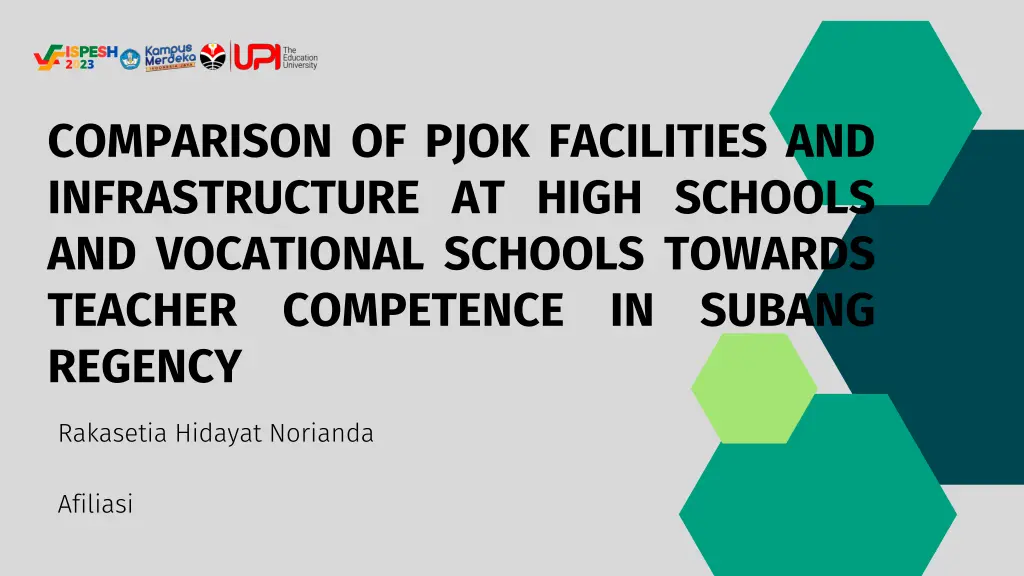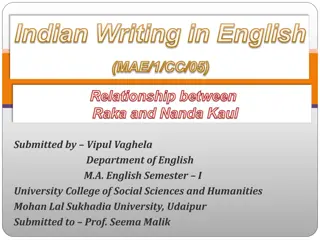
Comparison of PJOK Facilities and Infrastructure at Schools in Subang Regency
This study examines the comparison of Physical Education facilities and infrastructure at high schools and vocational schools in Subang Regency, Indonesia, focusing on teacher competence. The success of the learning process depends on effective management and facilitation by teachers, highlighting the importance of adequate facilities for physical education to support students' development. Methodologically, a descriptive approach with a quantitative survey method was used to collect data and compare educational facilities in different school settings.
Download Presentation

Please find below an Image/Link to download the presentation.
The content on the website is provided AS IS for your information and personal use only. It may not be sold, licensed, or shared on other websites without obtaining consent from the author. If you encounter any issues during the download, it is possible that the publisher has removed the file from their server.
You are allowed to download the files provided on this website for personal or commercial use, subject to the condition that they are used lawfully. All files are the property of their respective owners.
The content on the website is provided AS IS for your information and personal use only. It may not be sold, licensed, or shared on other websites without obtaining consent from the author.
E N D
Presentation Transcript
ISPESH 2023 COMPARISON OF PJOK FACILITIES AND INFRASTRUCTURE AT HIGH SCHOOLS AND VOCATIONAL SCHOOLS TOWARDS TEACHER COMPETENCE IN SUBANG REGENCY Rakasetia Hidayat Norianda Afiliasi
ISPESH 2023 INTRODUCTION INTRODUCTION Education in Indonesia, encompassing both public and private institutions, is vital for national progress. According to Law No. 20 of 2003, the goal of education is to create a learning environment that fosters the development of students' potential, including spiritual strength, self-control, personality, intelligence, character, and essential skills for themselves and society (Knekta et al., 2022). Physical education plays a significant role in this developmental process, enhancing students' abilities and potential (Korzun & Kaliada, 2022). Wu, Liu, and Xu (2023) describe physical education as a structured process aimed at developing physical abilities, skills, and personality within a social context. The interaction between teachers and students is crucial, with teachers acting as professional educators responsible for educating, teaching, guiding, directing, training, assessing, and evaluating students, as mandated by Law No. 14 of 2005.
ISPESH 2023 The success of the learning process heavily relies on teachers' ability to manage and facilitate learning effectively (Prestika et al., 2020). National education standards, as per Government Regulation No. 19 of 2005, establish minimum criteria for educational systems and infrastructure, including learning spaces, sports facilities, places of worship, libraries, laboratories, and ICT facilities. However, limited numbers of educators and insufficient physical education facilities can hinder the learning process and restrict students' engagement in necessary physical activities (Sulaksana et al., 2020). Therefore, it is essential to provide and manage adequate physical education facilities to ensure a smooth and effective learning process that supports students' fitness and overall development.
METHODS ISPESH 2023 This study used a descriptive method to describe the existing situation or events. The survey method with a quantitative approach through the distribution of questionnaires was used to collect data on knowledge, infrastructure, and learning outcomes of Physical Education. Learning outcomes were obtained through interviews with one PJOK teacher at the researched school. This study used a Cross-Sectional Survey design to compare infrastructure in two different schools. Data were collected at one specific time to compare educational facilities in high schools and vocational schools throughout Subang Regency. Data collection was done through closed questionnaires for time, cost efficiency, and ease of data processing. Respondents were asked to choose answers that matched their characteristics. The questionnaire contained statements related to infrastructure and teacher competence using a four-point Likert scale (1 = poor, 2 = fair, 3 = good, 4 = excellent). Teacher competence includes important aspects of performing professional duties such as pedagogical competence, professional competence, and social competence. Meanwhile, infrastructure used standards from the Indonesian Ministry of National Education Regulation No. 24 of 2007 on infrastructure standards for schools. In this study, descriptive statistical approaches were used to analyze data. Subsequently, data were processed and analyzed using normality tests, homogeneity tests, and one sample T-test with SPSS version 26. No Subang Selatan Subang Kota Subang Utara 1 SMAN 1 Jalancagak SMAN 1 Subang SMAN 1 Pamanukan 2 SMAN 1 Tanjungsiang SMAN 3 Subang SMAN 1 Pusakanagara 3 SMK Tunas Bangsa Ciater SMAN 4 Subang SMKN 1 Pusakanagara 4 SMK Budi Agung Jalancagak SMK PGRI Subang SMK Darul Maarif Pamanukan 5 SMK Swasta Bina Nusantara Cisalak SMK Swasta Kesehatan SMK Swasta Sukamandi Ciasem 6 SMK Tri Mitra 2 Cikaum
ISPESH 2023 RESULT AND DISCUSSION The research highlights differences in sports facilities and teacher competency scores across three regions and between school types in Subang Regency: Regional Differences: South Subang: Sports facilities: Soccer fields, volleyball courts, basketball courts, table tennis courts, badminton courts. Teacher competencies: High in pedagogical and professional areas, lower in social competency. Subang City: Sports facilities: Same as South Subang. Teacher competencies: High in pedagogical and professional areas, adequate in social competency. North Subang: Sports facilities: Same as South Subang. Teacher competencies: Good in pedagogical and professional areas, slightly lower in social competency compared to the other regions. School Type Differences: Vocational high schools (SMK/SMKN): More sports fields, table tennis courts, basketball courts, sports balls, and equipment. Higher scores in pedagogical and professional competencies. General high schools (SMA/SMAN): More shuttlecocks, cones, and skipping ropes. Higher scores in social competency. The findings illustrate the intricate relationship between physical education infrastructure and teacher competencies, indicating that better facilities support higher competency development.
ISPESH 2023 The research reveals variations in sports facilities and teacher competency scores across South Subang, Subang City, and North Subang. All three regions have similar sports facilities, including soccer fields, volleyball courts, basketball courts, table tennis courts, and badminton courts. Teacher competencies are high in pedagogical and professional areas in all regions, though South Subang and North Subang show slightly lower social competency scores. A comparison between vocational high schools (SMK/SMKN) and general high schools (SMA/SMAN) in Subang Regency indicates that SMK/SMKN have more extensive sports facilities and higher scores in pedagogical and professional competencies, while SMA/SMAN excel in social competency. These findings underscore the complex relationship between physical education infrastructure and teacher competencies, highlighting the importance of adequate facilities in supporting competency development.
CONLUSION CONLUSION ISPESH 2023 The conclusion of this study indicates that physical education infrastructure, such as sports fields and equipment, significantly affects teacher competencies in Subang Regency. The research found significant variations in sports facilities in South Subang, Subang City, and North Subang, which influence the pedagogical, professional, and social competency scores of teachers. Although general high schools (SMA/SMAN) have more sports equipment, vocational high schools (SMK/SMKN) show higher scores in pedagogical and professional competencies. These findings highlight the importance of providing and managing adequate sports infrastructure to improve the quality of education by enhancing teacher competencies.
REFERENCES REFERENCES ISPESH 2023 Baharuddin, L. (2015). SURVEI SARANA DAN PRASARANA PENJASORKES DI SMP NEGERI SE- KECAMATAN PURWAREJA KLAMPOK KABUPATEN BANJARNEGARA TAHUN AJARAN 2012/ 2013. Active: Journal of Physical Education, Sport, Health and Recreation, 4. Hartanto, T.M., Susanto, N., Saputra, N., Abdussyukur, A., & Kartiko, A. (2023). The Influence of Teacher Professional Competence on Education Quality Through Infrastructure as an Intervening Variable. Tafkir: Interdisciplinary Journal of Islamic Education. Knekta, E., Almarlind, P., & Ottander, C. (2022). The purpose of science education. Nordic Studies in Science Education. Kompri. (2014). Manajemen Sekolah Teori dan Praktek. Bandung: Alfabeta. Korzun, D., & Kaliada, V. (2022). Physical education as a basis for healthy and creative personal development of school and university students. Tambov University Review. Series: Humanities. Peraturan Pemerintah Republik Indonesia. (2017). Standar Nasional Pendidikan. Peraturan Pemerintah Nomor 19 Tahun 2005 Pasal 1 ayat 1. Rostikawati, Y., Aeni, E., & Wuryani, W. (2020). PERAN GURU DALAM MEMBENTUK KARAKTER SISWA MELALUI PEMBELAJARAN KESANTUNAN BERBAHASA DI MEDIA SOSIAL. , 3, 112-120. Saniatu Nisail Jannah, & Uep Tatang Sontani. (2018). Sarana dan Prasarana Pembelajaran Sebagai Faktor Determinan terhadap Motivasi Belajar Siswa. Jurnal Pendidikan Manajemen Perkantoran, 3(1), 63-70. Sianturi, R. (2022). Uji homogenitas sebagai syarat pengujian analisis. Jurnal Pendidikan, Sains Sosial, Dan Agama, 8(1), 386 397. Sugiyono. (2020). Metode Penelitian Kuantitatif, Kualitatif, dan R&D. Alfabeta. Sutrisno, S., Hayati, H., Saputra, N., Arifin, S., & Kartiko, A. (2023). The Influence of The Head of Madrasah and Infrastructure Facilities on The Quality of Education Through Teacher Competence. Tafkir: Interdisciplinary Journal of Islamic Education. Theodora Gunung Pukan. (2020). Pengaruh Sarana dan Prasarana Untuk Meningkatkan Kualitas Pendidikan di SDI Luki Kecamatan Wulandoni. Jurnal Mitra Pendidikan, 4(11), 714-730. Undang-Undang Republik Indonesia. (2017). Undang-Undang Republik Indonesia Nomor 20 Tahun 2003 tentang Sistem Pendidikan Nasional. Wu, C., Liu, B., & Xu, L. (2023). Exploration of Physical Education Teaching Design and Student Ability and Character Cultivation Based on Positive Psychological Influence. International Journal of Membrane Science and Technology.




